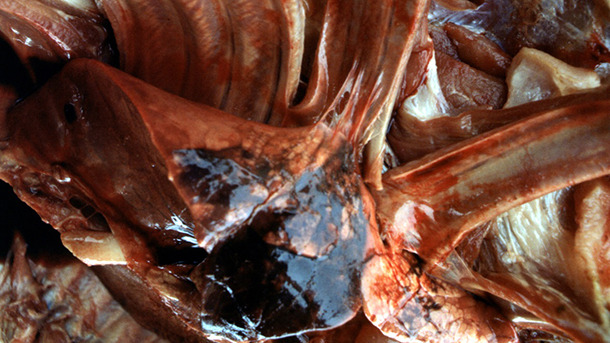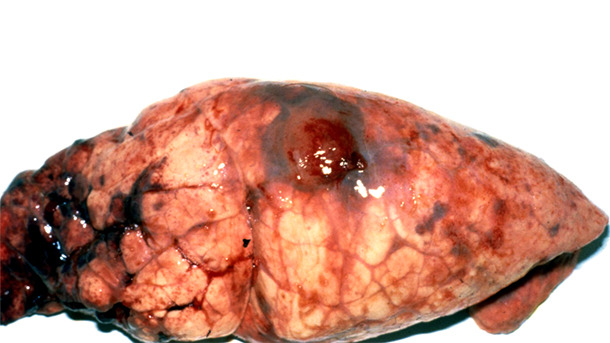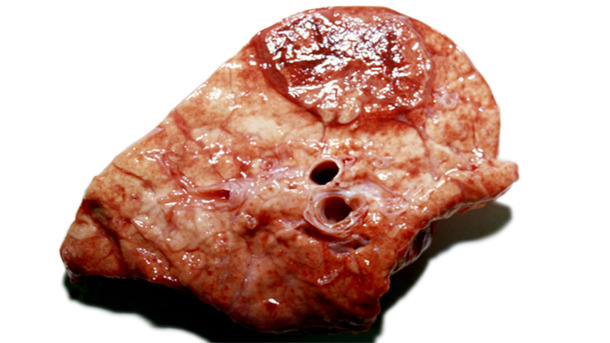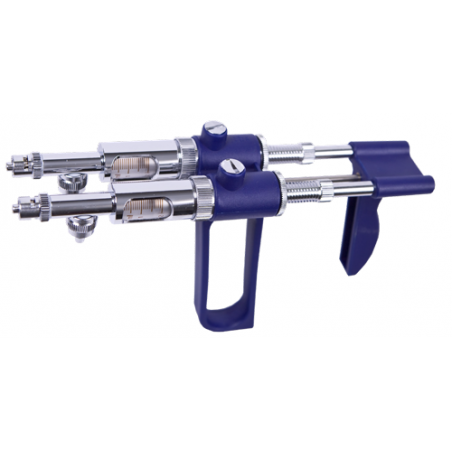In this second article, the aim is to look at the longer term implications of Actinobacillus pleuropneumoniae (App) infection in a herd and its control.
Following a primary breakdown within a continuously occupied site or one that is supplied by a continuously producing infected herd, a number of possible scenarios can occur.

- Disease disappears with no long-term clinical or pathological signs.
- Infection may subside but still cause occasional acute flare-ups.
- App becomes part of the "soup" that constitutes Porcine Respiratory Disease Complex in conjunction with other agents particularly Mycoplasma hyopneumoniae and PRRS. This is most likely in poorer health herds or continuous production systems, often with high stocking rates, age mixing and airflow management issues.
- Chronic disease occurs in individual pigs and over the wider population. Typically, this will occur in growing pigs above 10 weeks old and is likely to present clinically as occasional "poor doing" pigs, moderate background coughing in the herd, reduced growth rates and raised herd mortality. At slaughter, chronic fibrous pleurisy will be seen, along with chronic necrotising pleuropneumoniae lesions. Typically, this scenario persists in larger populations (e.g. 1000 sow plus herds).

Figure 1. Organised fibrous pleurisy following previous App challenge.

Figure 2. Chronic core lesion typical of App – the haemorrhagic and necrotic lung lesion is overlain with pleural tags.

Figure 3. A similar lesion in section.
The epidemiology of chronic App is driven by a cycle of infection from the source breeding herd with waning maternally derived immunity allowing infection beyond 9-10 weeks of age, replication and excretion of the bacteria, reinfection of younger following pigs and continual top-up of infection and immunity in sows. Control principles are based around breaking the cycle but with the need to remove the source infection from the breeding animals, which are often asymptomatic carriers and reduce rollover infection between age groups.
Strategies for control depend on the management system in place, with batch farrowing and split site rearing and "All in All out" pig flow providing the best control opportunity. The greatest challenge is presented by the large, continuously occupied breeder-feeder site. The process also involves decisions as to whether elimination of disease or control of enzootic infection is sought.
Elimination can best be achieved by total depopulation, cleaning and disinfection, and restocking with disease free stock. The existence of the APXIV serological test gives more reliable screening results than the old complement fixation tests for specific serotypes but assessment of herd freedom from disease is still based fundamentally on absence of clinico-pathological signs. Elimination by partial depopulation and medication can be successful. Removal of pigs from the site at weaning accompanied by treatment regimens with antibiotics such as tulathromycin or ceftiofur or fluorquinolones (subject to responsible use considerations) in both sows and piglets have been successful as has prolonged treatment of sows with tilmicosin in feed accompanying piglet treatments; programmes are more likely to succeed if batch farrowing is practised, or a break in farrowing can be achieved. (They can be combined with mass vaccination techniques and breeding herd closure to achieve multiple disease elimination.) It has not proved possible to actively eliminate App from chronically affected permanently occupied breeder-feeder herds.
If geographical, economic or practical considerations preclude disease elimination, long term control measures must be used. Antimicrobial treatment at specific high risk stages is the simplest method available and, if predictable, use of, for example, 2 weeks’ in feed medication with tilmicosin or individual injection with tulathromycin can be highly effective at suppressing disease, and reducing lesions at slaughter. Alternatively 5 days’ water based medication may be used metaphylactically, in particular closer to slaughter where shorter withdrawal periods apply. In extreme situations where disease is seen repeatedly close to slaughter, antibiotics with short withdrawal periods such as tiamulin via feed or water are successful, but the long term or permanent use of prophylactic antibiotic medication is no longer deemed to be acceptable.
Control via vaccination has proved reliable either using commercial vaccines or autogenous vaccines prepared from the specific isolate from the affected farm. Such products are a costly long term solution and the effect on the epidemiology within a herd must be considered. Typically, if the vaccine is given at, say, 9 &12 weeks of age in a breeder-feeder farm, the effect of reduced disease in growers may lower "top up" challenge to sows leading to lower maternally derived antibodies. The disease can creep back and affect younger pigs progressively. This dynamic situation requires continual readjustment of the vaccine programme and may ultimately require vaccination of both breeding and feeding herds to maintain stability.
Where commercial vaccines are based on APX toxins and membrane proteins, it is no longer necessary – other than for epidemiological purposes – to serotype the strain prior to introducing a vaccine programme.






